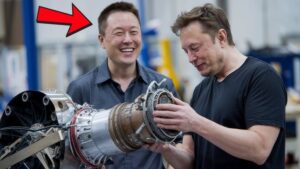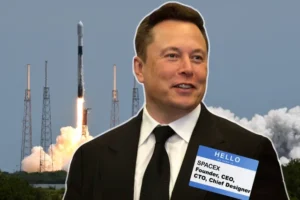In the early 2000s, a young entrepreneur named Elon Musk walked into a room full of seasoned aerospace experts, his mind buzzing with audacious dreams of colonizing Mars. Armed with little more than a fortune from his internet ventures and a relentless curiosity, Musk was on a mission to revolutionize space travel. But during one fateful encounter, an engineer—unaware of the firebrand standing before him—laughed at Musk’s attempt to troubleshoot a rocket problem. The engineer had no idea who he was dealing with, and that moment of skepticism would become a spark in the origin story of SpaceX, a company that would redefine the boundaries of human exploration.
This isn’t just a tale of a single laugh; it’s a window into the tenacity, ingenuity, and defiance that propelled Musk from an outsider in the aerospace world to the architect of a private space empire. Let’s rewind to the early days of SpaceX, when Musk’s vision was met with raised eyebrows, and uncover how a moment of doubt became a catalyst for one of the most remarkable success stories in modern history.
The Genesis of a Space Dream
Born in Pretoria, South Africa, in 1971, Elon Musk was no stranger to big ideas. By the time he was 30, he had already founded and sold two companies—Zip2 and X.com (which became PayPal)—amassing a fortune that gave him the freedom to chase loftier goals. While many would have settled for a life of luxury, Musk’s sights were set on the stars, quite literally. Inspired by his passion for making humanity a multi-planetary species, he became obsessed with the idea of sending missions to Mars, starting with a small payload of plants or mice to demonstrate life could survive on the Red Planet.
In 2001, Musk’s journey into space began with a bold but naive plan: buy a rocket. He reached out to Russian aerospace firms, hoping to purchase a refurbished intercontinental ballistic missile (ICBM) to launch his Martian experiment. Accompanied by aerospace consultant Jim Cantrell and his friend Adeo Ressi, Musk traveled to Moscow, where he encountered a frosty reception. The Russian engineers, seasoned by decades of Cold War-era rocketry, saw Musk as a brash newcomer with more money than sense. During one meeting, a chief designer reportedly spat on Musk’s shoes, dismissing his ambitions as fanciful. The humiliation stung, but it also lit a fire within him. On the flight back, Musk declared he would build his own rockets, and SpaceX was born in 2002.
The Laugh That Echoed
The anecdote of an engineer laughing at Musk’s attempt to fix a rocket likely stems from the chaotic early days of SpaceX, when the company was a ragtag group of engineers working out of a nondescript warehouse in El Segundo, California. Musk, who appointed himself CEO and Chief Engineer despite lacking formal aerospace training, was deeply involved in every aspect of the company. He devoured textbooks like Rocket Propulsion Elements and Fundamentals of Astrodynamics, borrowing them from experts like Cantrell (and, legend has it, never returning them). Musk’s self-education was relentless, but to industry veterans, he was still an untested entrepreneur playing in a field dominated by giants like Boeing and Lockheed Martin.

A tense moment in the SpaceX workshop, where a prototype rocket component—perhaps an actuator or a valve—was malfunctioning. Engineers, many of whom had left stable jobs at established firms to join Musk’s quixotic venture, were troubleshooting under pressure. Musk, with his characteristic hands-on approach, stepped in, offering a suggestion based on his rapidly growing knowledge. To one engineer, unaware of Musk’s identity or his role as the company’s founder, the idea seemed absurd. A chuckle escaped, perhaps laced with condescension. “Who is this guy?” the engineer might have thought, oblivious that the man he was dismissing was the driving force behind the entire operation.
While the specifics of this encounter remain anecdotal, it encapsulates the skepticism Musk faced. SpaceX was a startup with no track record, competing in an industry where failure could cost millions—or lives. The engineer’s laughter wasn’t just a personal slight; it was a reflection of the broader doubt that Musk was up against. Yet, rather than retreat, Musk doubled down, using criticism as fuel to prove the naysayers wrong.
Building SpaceX Against the Odds
SpaceX’s early years were a crucible of trial and error. Musk invested $100 million of his own fortune, but the company burned through cash quickly. The team, a mix of brilliant misfits and risk-takers, worked grueling hours to design the Falcon 1, a small rocket intended to deliver satellites into orbit. Musk’s leadership style was intense—some called it relentless, others sadistic. He demanded impossible timelines, once telling an engineer tasked with building a $120,000 actuator that it should cost no more than $5,000, comparing it to a garage door opener. The engineer, Steve Davis, spent nine months delivering the part, a testament to Musk’s ability to push his team beyond their limits.
The road to success was paved with failures. The first three Falcon 1 launches, between 2006 and 2008, ended in disaster—explosions, crashes, and heartbreak. Each failure brought SpaceX closer to bankruptcy, but Musk refused to quit. “I don’t ever give up,” he later said, reflecting on those dark days. The fourth launch in 2008 was a make-or-break moment. With funds nearly depleted, the team poured everything into the rocket. This time, it soared, reaching orbit and securing SpaceX’s first success. The engineer who once laughed might have been among those cheering, realizing the “novice” he mocked was rewriting the rules of spaceflight.
From Laughter to Legacy
That moment of mockery, however fleeting, was a microcosm of Musk’s journey. He wasn’t a traditional rocket scientist, but he didn’t need to be. His strength lay in his ability to learn, adapt, and inspire. Musk absorbed knowledge from experts like Tom Mueller, SpaceX’s propulsion genius, while challenging conventional wisdom. He questioned why rockets couldn’t be reusable, a concept dismissed as impractical by industry veterans. Today, SpaceX’s reusable Falcon 9 and Starship rockets have slashed launch costs, making space more accessible than ever.

By 2010, SpaceX achieved what many thought impossible: it became the first private company to launch a spacecraft into orbit and return it to Earth. Two years later, its Dragon capsule docked with the International Space Station, a feat that cemented SpaceX’s place in history. The company’s innovations didn’t stop there. The Falcon Heavy, the most powerful operational rocket in the world, and the Starlink satellite constellation have further solidified SpaceX’s dominance. Musk’s vision of Mars, once a punchline, is now a tangible goal, with Starship designed to carry humans to the Red Planet.
The Power of Being Underestimated
The engineer’s laughter wasn’t just a moment of doubt; it was a gift. It reminded Musk that the world wouldn’t hand him success—he’d have to seize it. Every snicker, every spat shoe, every failed launch only sharpened his resolve. Musk’s story is a lesson in the power of being underestimated. He didn’t need a Ph.D. in aerospace to change the industry; he needed the audacity to try, the humility to learn, and the grit to persevere.
Today, SpaceX is valued at over $100 billion, and Musk is a household name, celebrated as TIME’s Person of the Year in 2021 and reviled by critics who see him as a polarizing figure. But back in that warehouse, when an engineer laughed, Musk was just a man with a dream and a chip on his shoulder. That laughter didn’t stop him—it launched him.
As SpaceX prepares for its next chapter, from lunar missions to Martian colonies, the world watches not with skepticism but with anticipation. The engineer who laughed may never be named, but his role in this saga is undeniable. He was a spark, a challenge, a reason to keep going. And in the end, Musk’s rockets didn’t just reach orbit—they reached for the stars.



